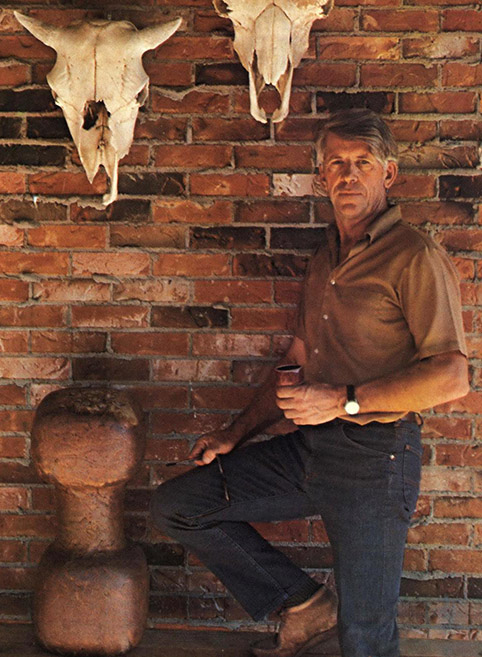| Monthly Tech-Tip | No tracking! No ads! | |
Crazed iron reduction fired vase by Luke Lindoe
The glaze is made from nearly 100% nepheline syenite, thus guaranteeing that it would craze. The piece was fired at cone 6 reduction using cone 10R bodies, achieving a redder fired color (because of low vitrification). The clay body is H440. These types of pieces were made during the 1970s and 1980s.
Related Pictures
Mosaic mural in Dan McCharles Park - made by Luke Lindoe in 1961

This picture has its own page with more detail, click here to see it.
The mural is made from unglazed stained stoneware tiles, each cut to shape. The inscription reads: "THE DOCTOR OF TODAY TAKES HIS PLACE AT THE HEAD OF A VERY LONG LINE OF DISTINGUISHED PREDECESSORS; THE KNOWLEDGE AND TRADITION THAY MAKES THE MEDICAL PROFESSION WHAT IT IS TODAY GROWS FROM
THE GREAT DOCTORS OF THE NINETEENTH CENTURY AND OF MEDIEVAL EUROPE, OF GREECE, OF EGYPT AND BEYOND - LOST IN THE PAST. THIS MOSAIC PAYS TRIBUTE TO THAT VAST HISTORY."
Large sculpture by Luke Lindoe - 1967

This picture has its own page with more detail, click here to see it.
This is housed on the lower floor of the Medicine Hat public library. It is a testimony to the skill Luke Lindoe, this heavy piece has no visible cracks. Made at the time Plainsman Clays was just starting. Luke did not have a high-temperature red burning clay to be able to make the warm colors of H440, for example (this employs the clays available in the I-XL Brick suite of raw materials). He did have materials mined around Elkwater, two of them he could have used were 45R, a low-fire red similar to BGP, and 45D, a medium-fire plastic material. These types of materials would have limited firing temperature to around cone 2. But Luke would also have been aware of the more refractory clays around Ravenscrag, Sask and could have been processing them himself - that would have enabled a high-temperature body for gas firing in a reduction atmosphere.
Luke Lindoe in 1971

This picture has its own page with more detail, click here to see it.
He was the founder of Plainsman Clays. My dad had just built the Plainsman Clays factory for him and I began working there in 1972 (this picture was taken at his house, which my father also built). He was a well-known artist potter and sculptor at the time, having come out of the pottery production industry in the area. He got me started along the fascinating road of understanding the physics of clays. He was a true "plains man", interested in the geology of the plains (notice the skulls, these inspired the Plainsman logo). He got me started doing physical testing of raw clays (that he was finding everywhere). I was blown away by the fact that I could assess a completely new material and judge its suitability for many types of ceramic products and processes by doing the simple physical tests he showed me. It got started writing software to log the data for that back in the 1980s, that eventually led to digitalfire.com and Insight-live.com.
Videos
Links
Got a Question?
Buy me a coffee and we can talk

https://digitalfire.com, All Rights Reserved
Privacy Policy

